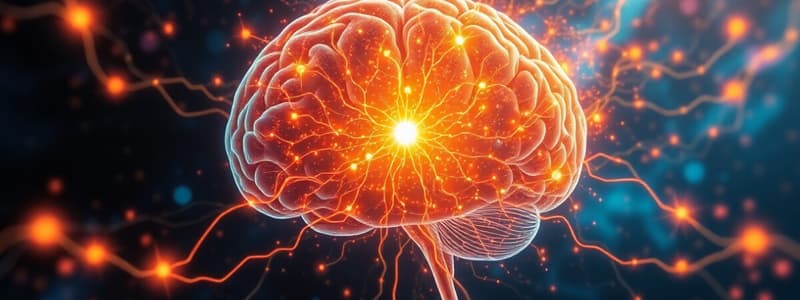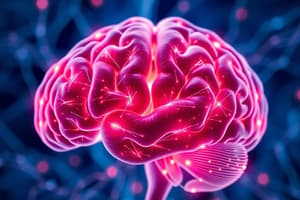Podcast
Questions and Answers
What is the primary role of gyri and sulci in the human brain?
What is the primary role of gyri and sulci in the human brain?
- To regulate body temperature
- To facilitate communication between hemispheres
- To enhance the production of neurotransmitters
- To increase the amount of cortex in the cranial cavity (correct)
Aphasia only affects spoken language and does not impact written language.
Aphasia only affects spoken language and does not impact written language.
False (B)
What type of brain waves are associated with deep sleep?
What type of brain waves are associated with deep sleep?
Delta waves
The __________ lobe is responsible for voluntary motor functions and motivation.
The __________ lobe is responsible for voluntary motor functions and motivation.
Match the types of brain waves with their corresponding states:
Match the types of brain waves with their corresponding states:
Which statement about cerebral lateralization is correct?
Which statement about cerebral lateralization is correct?
Which region of the brain is responsible for understanding spoken language?
Which region of the brain is responsible for understanding spoken language?
Disconnection syndrome occurs when the corpus callosum is intact.
Disconnection syndrome occurs when the corpus callosum is intact.
The left hemisphere of the brain is responsible for processing visual and spatial information.
The left hemisphere of the brain is responsible for processing visual and spatial information.
What is the primary function of the precentral gyrus?
What is the primary function of the precentral gyrus?
What part of the brain is responsible for sensory perception and voluntary motor actions?
What part of the brain is responsible for sensory perception and voluntary motor actions?
The ________ connects different regions within the same hemisphere of the brain.
The ________ connects different regions within the same hemisphere of the brain.
Match the following regions of the brain with their primary functions:
Match the following regions of the brain with their primary functions:
Which tract primarily crosses from one cerebral hemisphere to the other?
Which tract primarily crosses from one cerebral hemisphere to the other?
The neocortex constitutes 25% of the cerebral cortex.
The neocortex constitutes 25% of the cerebral cortex.
What is the role of the limbic system?
What is the role of the limbic system?
Flashcards
Gyri/sulci
Gyri/sulci
Folds (gyri) and grooves (sulci) in the brain that increase the surface area of the cerebral cortex.
Disconnection syndrome
Disconnection syndrome
A neurological condition where cutting the corpus callosum isolates the brain hemispheres, causing them to operate independently.
Aphasia
Aphasia
Language impairment caused by damage to specific brain regions like Wernicke's or Broca's area.
Nonfluent aphasia
Nonfluent aphasia
A type of aphasia characterized by slow and effortful speech, difficulty choosing words.
Signup and view all the flashcards
Cerebral lateralization
Cerebral lateralization
Differences in structure and function between the left and right cerebral hemispheres.
Signup and view all the flashcards
Prefrontal cortex
Prefrontal cortex
Part of frontal lobe, integrates sensory info and allows higher-level thinking (predicting outcomes).
Signup and view all the flashcards
Alpha waves
Alpha waves
Brain waves associated with a relaxed, awake state with closed eyes and a calm mind.
Signup and view all the flashcards
Delta waves
Delta waves
High-amplitude brain waves associated with deep sleep.
Signup and view all the flashcards
Cerebral Cortex Function
Cerebral Cortex Function
40% of brain mass, a layered gray matter structure primarily responsible for higher-level functions like thought, language, and memory.
Signup and view all the flashcards
Neocortex Function
Neocortex Function
Makes up 90% of the cerebral cortex, a six-layered tissue part of the cortex with more recent evolutionary origin.
Signup and view all the flashcards
Postcentral Gyrus Function
Postcentral Gyrus Function
Site where sensory input becomes conscious; exhibits somatotopy, a point-to-point correspondence between body areas and brain areas.
Signup and view all the flashcards
Primary Visual Cortex Function
Primary Visual Cortex Function
Receives visual signals from the eyes.
Signup and view all the flashcards
Primary Motor Area (Precentral Gyrus)
Primary Motor Area (Precentral Gyrus)
Sends signals to the brainstem and spinal cord, controlling muscle contractions.
Signup and view all the flashcards
Wernicke's Area Function
Wernicke's Area Function
Located in the left hemisphere, responsible for understanding spoken and written language.
Signup and view all the flashcards
Broca's Area Function
Broca's Area Function
Located in the left hemisphere, involved in generating the motor movements for speech.
Signup and view all the flashcards
Limbic System Function
Limbic System Function
Central to emotion and learning, linking conscious functions with emotional states and memory storage and retrieval.
Signup and view all the flashcardsStudy Notes
Terms
- Gyri/sulci: Increase the amount of cortex in the cranial cavity.
- Disconnection syndrome: Occurs when the corpus callosum is severed, causing each hemisphere to be unaware of the other.
- Aphasia: Language deficits due to lesions in Wernicke's or Broca's areas.
- Nonfluent aphasia: Characterized by slow speech and difficulty choosing words.
- Fluent aphasia: Involves the creation of made-up words.
- Cerebral lateralization: Structural and functional differences between the cerebral hemispheres, pronounced more in males.
Brain Functions
- Electroencephalogram (EEG): Records brain waves, used to study normal brain function, like sleep and consciousness. Lack of brain waves is a sign of brain death.
- Alpha waves: Indicate wakefulness, rest, and mind-wandering with eyes closed.
- Beta waves: Associated with mental activity and sensory stimulation.
- Theta waves: Common in children, intensely frustrated individuals, and drowsy/sleeping adults.
- Delta waves: High-amplitude waves typically found in deep sleep in adults.
Parts of the Brain
- Cerebrum: Responsible for sensory perception, memory, thought, judgment, and voluntary motor actions. Divided by a longitudinal fissure into two hemispheres.
- Cerebral hemispheres: Receive sensory information from and send motor commands to the opposite side of the body.
- Cerebral cortex: Contains white matter and specific functions aren't precisely linked to specific regions.
- Frontal lobe: Involved in voluntary motor functions, motivation, foresight (prefrontal cortex).
- Parietal lobe: Integrates general senses and taste, between the central sulcus and parieto-occipital sulcus.
- Occipital lobe: Primary visual center of the brain, located caudal to the parieto-occipital sulcus.
- Temporal lobe: Situated lateral and horizontal, below the lateral sulcus, involved with hearing, smell, learning.
- Insula: Deep within the lateral sulcus, linked to understanding spoken language and taste.
Cranial Nerves and other structures
-
Projection: Structures extending vertically between the cerebrum, lower brain, and spinal cord center.
-
Commissural: Connects different regions within the same hemisphere.
-
Corpus callosum: Important structure for commissural connections.
-
Association fibers: Connect different regions within the same hemisphere.
-
Limbic system: A complex system related to emotions and learning, from specific regions of cerebrum and diencephalon.
-
Postcentral gyrus: Sensory input processed here becomes conscious, spatial awareness.
-
Sensory areas: Receive and process sensory input from the body.
-
Visual cortex and auditory cortex: Crucial for processing visual and auditory sensory information.
-
Taste and smell areas: Processes taste and smell.
-
Precentral gyrus: (Primary motor cortex) sends signals to the brainstem and spinal cord, causing muscle contraction.
-
Language structures: Wernicke's and Broca's area are located in the left hemisphere for language processing and creation of spoken language.
-
Cranial nerves: A range of nerves with diverse functions, including sensory, motor, and mixed functions (e.g., olfactory, optic, oculomotor, etc.).
Studying That Suits You
Use AI to generate personalized quizzes and flashcards to suit your learning preferences.




